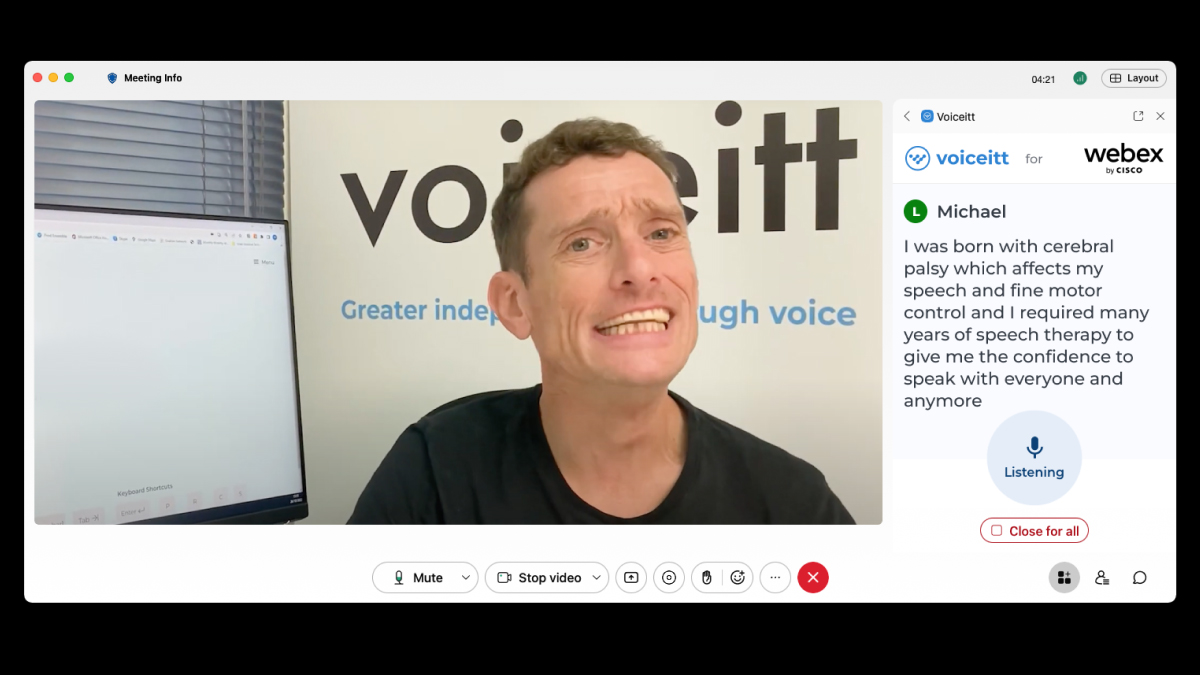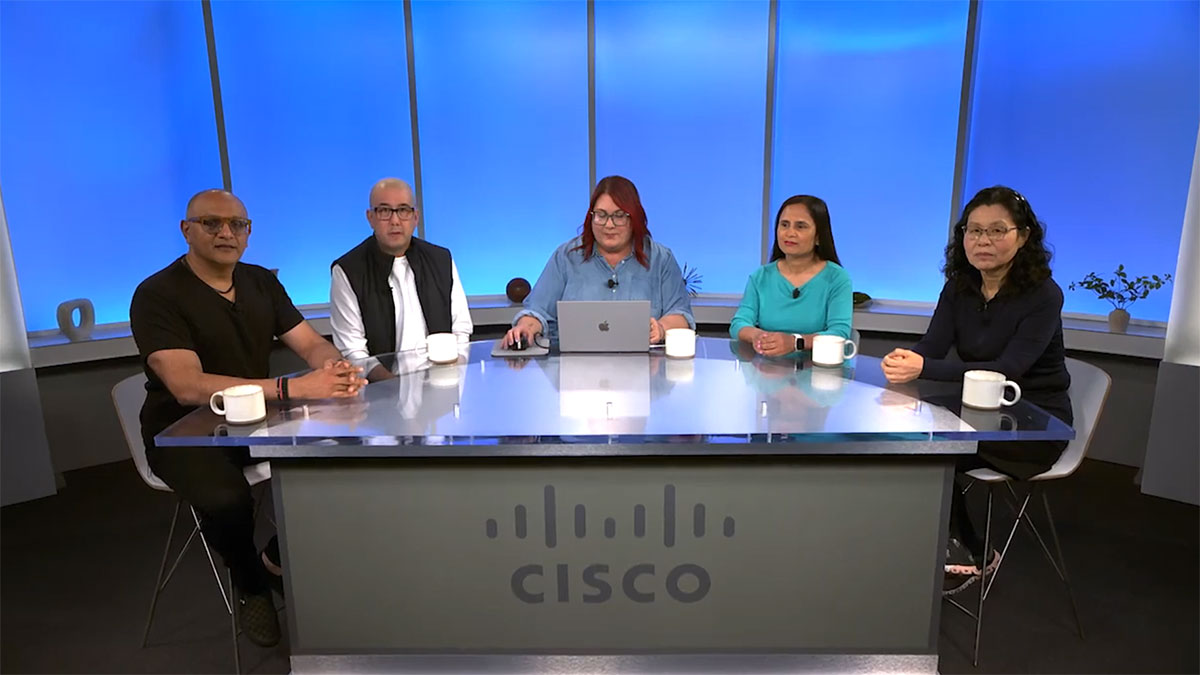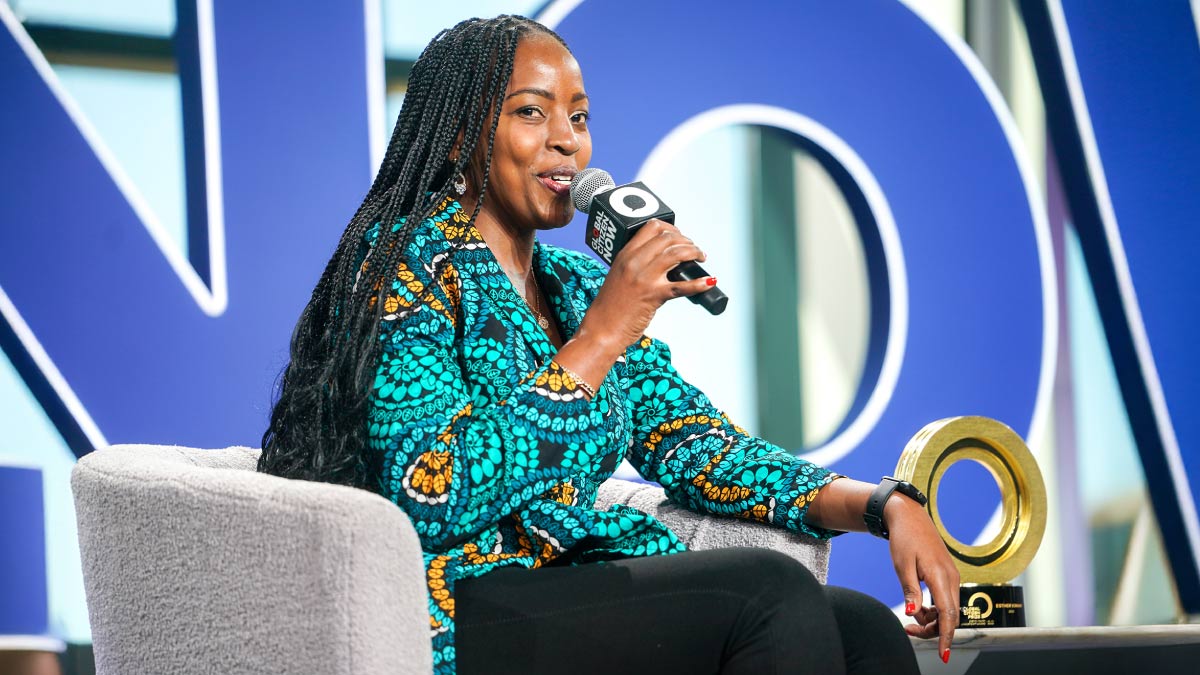Humans are compulsive communicators. And being able to connect with friends, family, and colleagues is fundamental to our well-being.
For the speech impaired, however, interactions that most of us take for granted can be a daily struggle.
That’s why a new partnership between Webex by Cisco and Voiceitt, an AI-powered program for people with non-standard speech, is so important. By learning the unique speech patterns of each user, Israel-based Voiceitt’s technology enables them to be understood in all new ways. And now, with its real-time captioning and transcription integrated seamlessly with Webex, Voiceitt’s reach will be scaled to a vast, global user base.
Michael Cash is already excited about the partnership’s promise. A Voiceitt employee with cerebral palsy who lives in the UK, he’s also a beta tester for the Voiceitt/Webex integration. He believes it has already transformed his virtual-meeting experience, as he can share his feelings, ideas, and humor as never before.
“When I introduce myself, you might pay attention to my voice before you pay attention to my words,” he said. “But at work, my words come alive, empowering me to do more, to express myself, and collaborate effectively.”
For Cisco, the Voiceitt partnership is a perfect match. Cisco is committed to making Webex the most inclusive collaboration platform in the world. And to that end, it has already introduced features like real-time language translation and noise reduction, so more people can contribute great ideas and capture opportunities from wherever they are.
“Webex's mission is to enable everyone to do their best work,” said Amit Barave, vice president for product management, Webex by Cisco, “and enable them to share their voices and capabilities and be able to collaborate no matter what their situation. But we felt we were not serving that section of people with non-standard speech as well as we could.”
When Cisco’s Aspire Fund began investing in Voiceitt in 2022, the Webex development team began assessing a technology partnership.
“It was very evident that there was a clear alignment in our mission and what Voiceitt is looking to address,” Barave continued. “And we were optimistic about the potential for a technology-level alignment as well.”
That optimism was well founded. In less than one year, the teams were ready to roll out a full integration of the two technologies.
Behind high-tech innovation, personal inspiration
For Voiceitt co-founder Sara Smolley, as with many of her colleagues, the commitment to innovation is personal. Smolley’s grandmother suffered from Parkinson’s, and as a child she saw first-hand the emotional impact that speech impairment can have — on those who struggle with it, as well as for their loved ones.
“We all started with our personal inspirations” she explained. “And what we began to learn as we spoke with what’s now become thousands in our community is that the underlying conditions affecting speech are quite diverse. And it touches so many people.”
Beyond that initial inspiration, the challenges were daunting. Capturing the nuances of mainstream speech is difficult enough, but non-standard speakers vary greatly in their conditions and style of speech. So, each user needs individual attention from the technology.
Machine learning and artificial intelligence make it possible. But powering the algorithms from a comparatively small data base of users was an early challenge.
“Any speech recognition system relies on huge amounts of voice data,” Smolley said, “millions, even billions of data points to support the algorithms and make them work reliably. In our case, we are tackling a unique problem. The first being trying to get high accuracy and reliable recognition with a relatively small amount of data.”
Another challenge is the many variances in non-standard, or dysarthric, speech, all of which demand more powerful algorithms that can understand the nuances, idiosyncrasies, and “error patterns” in each user’s speech.
“The mechanisms that need to essentially learn that speech must be more flexible,” said Dr. Rachel Levy, a speech language pathologist and customer success manager at Voiceitt. “It must understand the different characteristics that present themselves among, many different types of dysarthric speakers, even just within one diagnosis.”
A force for inclusion: simplicity
Even more so than technology for mainstream users, the Voiceitt user interface also needed to be intuitive and user friendly. Speech impairment can be one element of wider challenges, anything from Parkinson’s and stroke to cerebral palsy or cognitive issues.
“Another challenge,” Levy added, “is if someone has a literacy or visual impairment, how are they going to read initial prompts in order to teach the technology? What about a dexterity challenge where something as simple as pressing record is difficult? So, we’ve given a lot of insight into how we can better serve these end users and customers, some of whom may be integrating our core technologies into voice interface products.”
Given such challenges, simplicity and flexibility are essential for users and caregivers alike and must be considered at every design stage.
“It takes user-experience design to an entirely different level,” said Alyson Pace, Voiceitt’s co-CEO. “So, things like the size of the buttons, the ability to read them, the location that they are on the screen. Even as we're working with WebEx on the integration, we have to take those things into consideration. It’s not easy for our users. And every step of the way has to be very thoughtful.”
Happily, the technology and innovations keep getting better. For example, it now takes less time for Voiceitt to learn an individual user’s speech patterns.
“We’re in a new world where voice AI is at the forefront,” Smolley said. “And we’re at a transition period, with new possibilities for our technology. So, the impact that we can have in our communities is growing.”
The partnership with Webex by Cisco will help scale that global community. The Voiceitt team felt a natural alignment with Cisco’s culture and core purpose: powering an inclusive future for all. And they’re excited about what the two companies can continue to accomplish.
“Scale is one of the main pieces,” Pace said. “But there’s also a shared vision in bringing these opportunities to the millions of Webex users. And from a product perspective, there’s great opportunities beyond just the meeting integration. So, in the partnership we’re exploring integration with Webex video devices and with Webex Contact Center. We haven't even scratched the surface on potential use cases.”
For Cisco’s Amit Barave, it all comes back to Cisco’s core purpose.
“We want Webex to be a truly inclusive platform,” he concluded, “for any kind of interaction that results in collaborative value. That’s what the Webex platform — and our partnership with Voiceitt — is all about supporting.”





